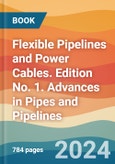FLEXIBLE PIPELINES AND POWER CABLES
Pipelines are an important part of the world's energy infrastructure, and, without them, oil and gas, the most commonly used sources for energy today, would not be available to much of the world's countries. New theories and designs are constantly being researched and developed by scientists and engineers, to continue improving this technology and making it safer and more economical.
The technology, processes, materials, and theories surrounding pipeline construction, application, and troubleshooting are constantly changing, and this groundbreaking series, "Advances in Pipes and Pipelines," has been created to meet the needs of engineers and scientists to keep them up to date and informed of all of these advances. This latest volume in the series focuses on flexible pipelines and power cables, offering the engineer the most thorough coverage of the state of the art available. The authors of this work have written numerous books and papers on these subjects and are some of the most influential authors on flexible pipes in the world, contributing much of the literature on this subject to the industry. This new volume is a presentation of some of the most cutting-edge technological advances in technical publishing.
This is the most comprehensive and in-depth series on pipelines, covering not just the various materials and their aspects that make them different, but every process that goes into their installation, operation, and design. This is the future of pipelines, and it is an important breakthrough. A must-have for the veteran engineer and student alike, this volume is an important new advancement in the energy industry, a strong link in the chain of the world’s energy production.
Table of Contents
Preface xxiii
Acknowledgements xxv
Part I: Design and Application 1
1 Introduction 3
2 Cross-Sectional Design of Unbonded Flexible Pipeline 23
3 General Design of Subsea Power Cables 33
4 Mechanical and Electrical Design of Subsea Power Cables 41
5 Joints and Termination of Subsea Power Cables 61
6 Multi-Physics Analysis of Cable 77
7 Design of Subsea Fiber Optic Cables 91
8 Manufacturing and Testing of Subsea Power Cables 101
9 Hydrodynamics 109
Part II: Global Analysis 125
10 Soil-Pipe Interaction 127
11 On-Bottom Stability Analysis 159
12 Pipelay Analysis 177
Part III: Mechanical Analysis 201
13 Reeling Operation of Flexible Pipelines 203
14 Flexible Pipelines Subjected to Asymmetric Loads 227
15 Stress Concentration Effect on the Anti-Burst Capacity 255
16 Compressive Buckling of Tensile Armours 273
17 Expansion and Global Buckling Analysis 287
Part IV: Stress and Fatigue Analysis 303
18 Effect of Ovalization on Stress of Tensile Armours 305
19 Confined Buckling and Collapse of Flexible Pipes 323
20 Wet Collapse of Flexible Pipes 345
21 Torsional Buckling of Flexible Pipes 377
22 Stress and Fatigue of Tensile Armours 413
23 Stress and Fatigue of Flexible Pipes Reinforced by Steel Strips 431
24 Mechanical Properties of Fiberglass Reinforced Flexible Pipe 439
25 Stress and Fatigue Analysis of Stranded Structures 483
26 Influence of Compaction Degrees on Power Cable Conductor Fatigue 507
27 Fatigue Life Estimation of Power Cable Copper Conductors 535
28 Global Fatigue Analysis of Power Cable Copper Conductors 561
29 Integrity Management of Flexible Pipes 581
Part V: Risk and Integrity Management 591
30 Failure Modes and Mechanisms for Flexible Pipes 593
31 Quantitative Risk Assessment for Flexible Pipes 605
32 Durability and 10000 Hours Test 617
33 Risk-Based Inspection Planning Methodology 627
34 Inspection of Flexible Pipes 655
35 Insertion Method for Pipe Repair 669
36 Repair Methods for Flexible Pipes 689
37 Lifetime Assessment for Flexible Pipes 705
38 Risk & Integrity Management of Subsea Power Cables 717
39 Inspection and Repair of Subsea Power Cables 729
References 744
About the Authors 747
Index 749








